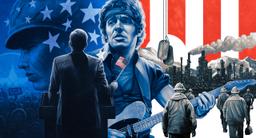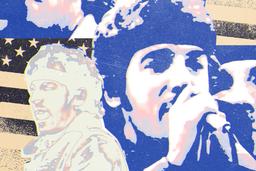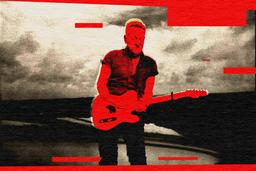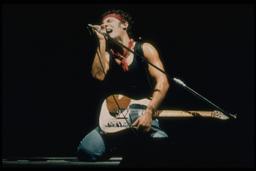Last month, Bruce Springsteen was in the news for doing Bruce Springsteen–type things. You probably heard about it from the Facebook boomer in your life, but here’s a quick recap: On May 14, he was on stage in Manchester, England, with the E Street Band. His hair was as gray as Alexander Hamilton’s, a sharp contrast with his bronzed skin and carved-in-granite, 75-year-old facial features. After extending the standard niceties about how pleased he was to be back in the U.K., he proceeded to provide a week’s worth of programming for stateside cable-news shows.
“The America that I love, the America I’ve written about that has been a beacon of hope and liberty for 250 years,” he declared, “is currently in the hands of a corrupt, incompetent, and treasonous administration.”
For those who bristle at famous musicians criticizing the president “on foreign soil,” it was an outrage. For apostles like Bono and Eddie Vedder, it was a call to action. What it wasn’t was unexpected. Calling out Donald Trump, particularly in times like these, is Bruce Springsteen’s job. It’s his version of hanging on the side of an airplane in a Mission: Impossible movie to save cinema.
The next week, Springsteen rush-released an EP culled from the Manchester concert. Of the six tracks, two are lengthy pre-song speeches about the meaning of the current sociopolitical moment. The first rap—the one about the “corrupt, incompetent, and treasonous administration”—precedes “Land of Hope and Dreams,” the 1999 song that represents Springsteen’s purest vision of America. A tolerant, welcoming place where “dreams will not be thwarted” and “faith will be rewarded.” The second sermon comes before “My City of Ruins,” a hymn of resilience in the face of extreme adversity that concludes his 9/11 album, 2002’s The Rising.
“They have no concern or idea of what it means to be deeply American,” Springsteen tells the audience. “The America that I’ve sung to you about for 50 years is real, and regardless of its faults, is a great country with a great people. So, we’ll survive this moment.”
This is the Bruce Springsteen who is rightly seen as a national monument, the larger-than-life character who, in the movie about his life set to be released this fall, is believed to have the ability to “repair the whole world.” The Bruce Springsteen who is adored by many, hated by others, but whose art is accepted as a symbol of what this country aspires to be.
But that is not the Bruce Springsteen I am most interested in right now. I care more about Goateed Bruce Springsteen.
I refer to the Boss incarnation that emerged in the 1990s, when Bruce was crossing the troublesome Rubicon of his mid-40s and experimenting with moody synthesizers and even moodier facial hair. The guy who won an Oscar for the song “Streets of Philadelphia,” from the 1993 Jonathan Demme film Philadelphia, and garnered respectful (though not overwhelming) accolades for the downbeat 1995 LP The Ghost of Tom Joad, one of his worst selling albums. Goateed Bruce Springsteen is withdrawn, introspective, and uninterested in making big rock ’n’ roll statements. His music is deliberately smaller, low-key, and intimate, the product of man trying to be just another normal middle-aged singer-songwriter.
By the end of the decade, however, that Bruce Springsteen disappeared, replaced by the same superhero Bruce Springsteen character who conquered the world in the ’80s and bashed Trump in 2025. But he wasn’t gone forever. In fact, Goateed Bruce Springsteen has had a surprising comeback this year.
One month before the Manchester concert, Springsteen released “Blind Spot,” the first taste of a massive and eagerly anticipated archival box set, Tracks II: The Lost Albums, due out this week. As the title suggests, the collection includes seven complete unreleased records, dating from the early ’80s to the late 2010s, six of which were once intended to come out as stand-alone releases until Springsteen held them back. (The seventh, a straightforward rock effort called Perfect World, includes scattered leftovers from the ’90s through the ’10s.)
“Blind Spot” is taken from Streets of Philadelphia Sessions, the so-called “loops record” that he recorded mostly by himself in 1994 and has since become a mythical object among hardcore fans. (In the liner notes, Springsteen relates a story about Brandon Flowers of the Killers visiting him recently and immediately saying “I want to hear the loops album.”) His intention was to elaborate upon the experiments of his only U.S. Top 10 hit from the ’90s, with canned beats and sullen synths (which he recently likened, evocatively, to “dark clouds”) replacing the meat-and-potatoes guitars and drums of his most famous work. But while “Streets of Philadelphia” diverged from the mean, “Blind Spot” represents a clean break from his usual image. At least “Philadelphia” has an underlying piety, with Bruce empathizing with a dying AIDS patient. “Blind Spot,” meanwhile, sounds like the soundtrack to a sleazy Paul Schrader erotic thriller, mixed with the romantic dissolution of his 1987 “divorce” record, Tunnel of Love.
“We inhabited each other / like it was some kind of disease,” he purrs, exuding a sexual menace not heard on a Springsteen record since “I’m on Fire” from Born in the U.S.A. “I thought I was flyin’/ But I was crawling on my knees.”
It’s a fantastic song. And Bruce almost put it out in 1995, before deciding at the last minute to reunite the E Street Band and record some songs for a greatest hits record. The heroic Bruce Springsteen character, again, prevailed. But that other Bruce, the quiet loner conjuring dark clouds, couldn’t be repressed forever.
Bruce Springsteen, as he once sang, is a cautious man. “I’ve always released my records with great care, making sure my narratives built upon one another,” he says in the liner notes of Tracks II. Typically, this has meant pairing triumphant arena-rock crowd-pleasers with palate-cleansing, “serious” downers—Born to Run and Darkness on the Edge of Town, The River and Nebraska, Born in the U.S.A. and Tunnel of Love, and so on. The purpose of this, he says, was “weaving a clear picture in my fans’ minds of who I was and where I was going in my work life at that moment.” With Tracks II, then, he’s finally showing us the records that “did not comfortably fit into that narrative, my creative arc.”
Along with Bob Dylan and Neil Young, Bruce Springsteen has a shadow career of unreleased music (or music put out many years after it was recorded) that rivals his “official” output. As a live performer, he is among the most bootlegged acts of all time, along with Dylan and the Grateful Dead. Nearly every public concert of consequence is available in some form, somewhere, in the deep recesses of the internet. (If you want to hear Bruce rip some sweet extended guitar solos with his pre-fame band Steel Mill, you’re just one canny Google search away.)
In terms of his studio work, Springsteen first opened the vaults in 1998, for the original Tracks box set. Over four discs, he shared buried gems from every era of his career up to that point, from acoustic demos for his 1973 debut Greetings from Asbury Park, N.J. to funky outtakes recorded in the early ’90s. The most treasured songs derived from his artistic prime in the late ’70s and early ’80s. While they weren’t organized into actual albums, like Tracks II, fans grouped these songs into their own fantastical “what if?” records, created alternate realities where songs like “Roulette” and “My Love Will Not Let You Down” became FM radio classics.
For most artists, the motherlode of Tracks—66 songs in all—would have amounted to an emptying of the coffers. For Springsteen, though, it was just the beginning. In 2010, he released The Promise, a double album of pop songs recorded in the late ’70s that he originally shelved in favor of the more spartan Darkness on the Edge of Town. Five years later, as part of a box set for The River, he put out The Ties That Bind, an album he set aside in 1979 after deciding to make a much larger record instead.
With Bob and Neil, you get the sense that decisions to not put out certain songs or even whole albums were impulsive. They are, if nothing else, unerringly “vibes based” artists. They are ruled by their guts. With Bruce, who might be the most thoughtful and self-aware of all the rock icons, the choices always seem exhaustively considered. For such a famously physical performer, he’s eternally locked in his own head. It’s never just about one album, and throwing something against the wall for the hell of it is anathema to him. “My creative arc,” as he puts it, is the project of his life.
And that approach has mostly paid off. Compared, again, with Bob and Neil, Bruce has a much higher hit rate. His catalog isn’t completely devoid of clunkers—shout-out to Working on a Dream and High Hopes—but he strikes out about as often as Tony Gwynn. But caution has its limitations. And carefully curating a persona can start to feel like a prison. As a Bruce Springsteen fan, I sometimes wish he had a few more “WTF?” moments, when he swung big and with reckless abandon. Bob and Neil have lots of records like that, and I value them along with their masterpieces.
I have long wished Bruce had his own Trans or Christmas From the Heart. In that sense, Tracks II is a dream come true. Not all of it is essential, but over 83 songs it’s never less than fascinating. Here, finally, we get to hear Bruce indulge in the stylistic departures that he normally keeps under wraps. The most radical is Twilight Hours, a companion record to 2019’s Western Stars in which he delves even deeper into Burt Bacharach/Jimmy Webb–style ’60s pop songwriting. While the songs are Springsteen originals, they ape the jazzy sophistication of American songbook standards, paired with hard-luck lonely guy lyrics fit for Watertown era Frank Sinatra. (Springsteen underlines the connection by emulating Frank’s whiskey-lacquered tenor, a curious affectation that works better than you might assume.)
Another curveball is Faithless, a soundtrack to a “spiritual Western” film that apparently never got made. Written and recorded in the mid-2000s in just two weeks during a sojourn in Florida, Faithless is Bruce at his most ethereal, with an emphasis on atmospheric instrumentals and a pronounced undercurrent of backwoods religiosity.
And then there are the Goateed Bruce Springsteen records. Based on his official releases, the ’90s are usually regarded as a relatively inactive period for Springsteen, with just three studio records—1992’s Human Touch and Lucky Town, along with Tom Joad—of inconsistent quality and low public interest. Tracks II’s most radical realignment of his “creative arc” is suggesting that the mid-’90s was something of a creative outburst for Springsteen, akin to his prodigious production during the early ’80s period that produced Nebraska and Born in the U.S.A. (as well as scores of beloved outtakes compiled on Tracks).
Three Tracks II albums originate, at least in part, from the Goateed Bruce Springsteen era. Somewhere North of Nashville, a hard-charging batch of country-flavored Springsteen originals mixed with some covers, is the least crucial artistically and the most promising commercially. (Bruce going country as a grunge era pivot in the age of Garth Brooks and Shania Twain would have made a lot of sense from a record executive’s perspective.) Though given that it was initially coupled with The Ghost of Tom Joad, a record it has nothing in common with sonically or thematically (even though they were recorded at the same time), not putting it out seems like an inevitable conclusion.
I prefer the quieter Inyo, a spiritual sequel to Tom Joad that appears to have been mostly made in the late ’90s. (The liner notes, otherwise detailed, don’t pinpoint a timeframe.) Like Tom Joad, Inyo is informed by Springsteen’s interest in the culture of Mexican immigrants in the American Southwest. Though the music is fuller than the sparse, semi-spoken word Joad. (A mariachi band even materializes on a few tracks.)
When asked about Inyo by The New York Times, he made an obvious parallel to current events. “There’s a large migrant population that lives and has altered Freehold in a very vibrant way,” he said, referring to his hometown. “There are communities all across America now that have taken in immigrants and migrant workers. So what’s going on at the moment to me is disgusting, and a terrible tragedy.” But the power of this muted, spooky, and often quite beautiful album is how he shows you the lives of the characters without telling you how to feel about their lives. That’s not something Goateed Bruce felt compelled to spell out. There are certainly politics on Inyo, as there are on Tom Joad, but they are of the ambient (rather than sloganeering) variety. You feel it in the consequences the protagonists are forced to endure, whether it’s a father mourning the loss of his daughter in a drive-by shooting (“El Jardinero (Upon the Death of Ramona)”), a troubled police detective on the verge of retirement (“One False Move”), or the citizens of a crumbling border town (“Ciudad Juarez”).
It’s indicative of what I love most about Tracks II—you get to hear Bruce Springsteen explore all the other Bruce Springsteens he doesn’t get to be on stage. Though, perhaps, not being the truth-telling Bruce Springsteen character is a luxury that present circumstances no longer allow.
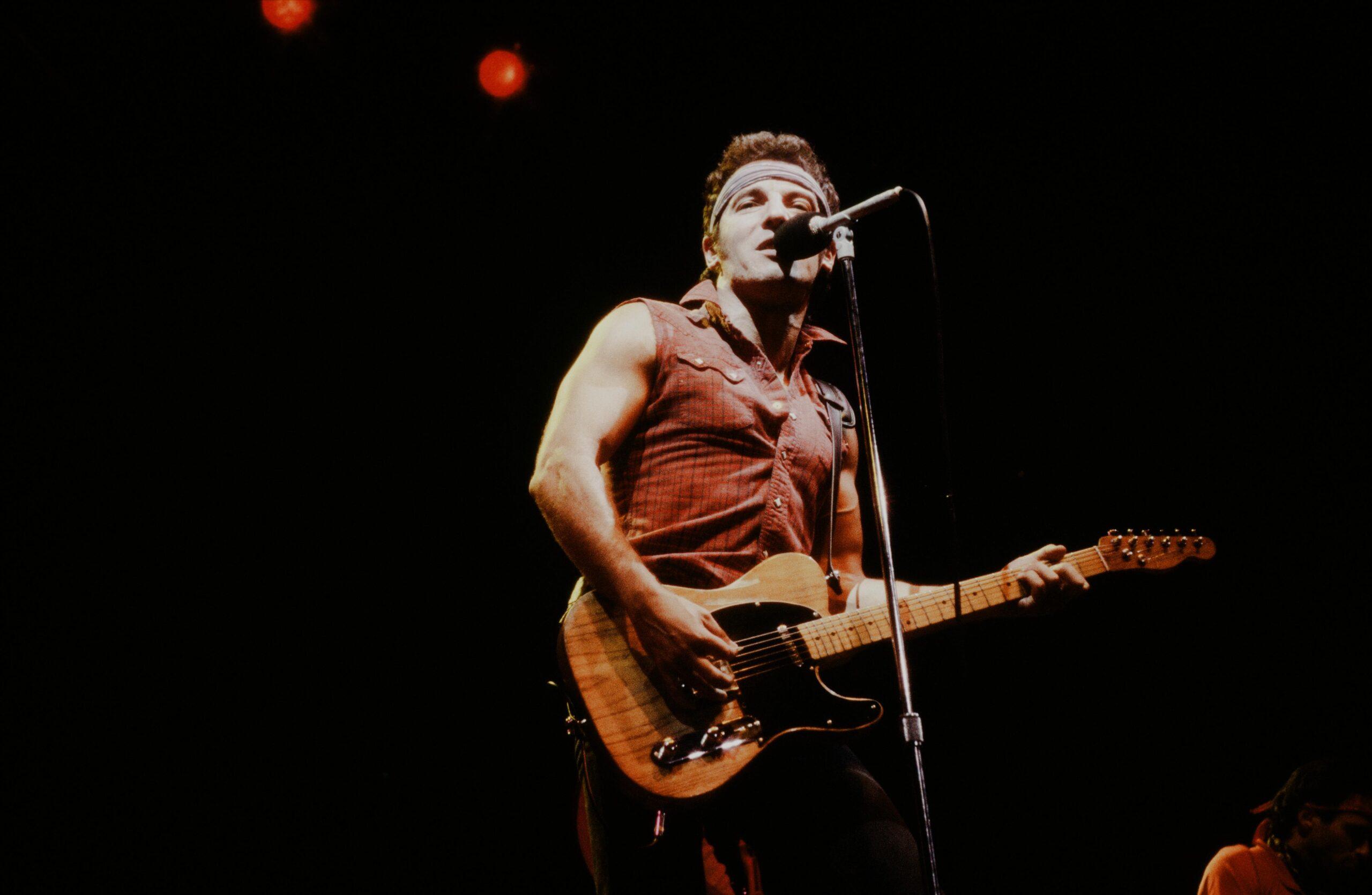
I suspect the Tracks II album that will generate the most interest is also the one that was easiest to track down as a bootleg. L.A. Garage Sessions ’83 contains 18 songs recorded after Nebraska came out in the fall of 1982, at which point Springsteen had already laid down the bulk of what would become his next record, the mega-selling Born in the U.S.A. (One of the L.A. Garage tracks is an early version of “My Hometown,” which sounds spritelier than the somber ballad that ultimately closed U.S.A.)
In my book about Born in the U.S.A., I wrote extensively about this version of Springsteen, which I dubbed “Depressed Early ’83 Bruce.” After Nebraska, he went on a cross-country road trip in a 1969 Ford XL with his close friend Matt Delia, with his new house in the Hollywood Hills as the destination. Upon arrival in Los Angeles, he poured his heart out to Jon Landau, manager/producer/all-around personal guru, confessing his profound inner despair. Landau connected Bruce with a therapist, and immediately upon arriving at his office, he burst into tears.
Bruce coped by setting up a basic recording studio at the house and working in the same manner in which he made Nebraska, only with instrumentation that pointed to Born in the U.S.A—electric guitars, synths, and drum machines. The result is music that sounds a lot like modern-day indie rockers who get labeled as “heartland rock,” like the War on Drugs or Kurt Vile. (It’s also the closest he’s come to emulating Suicide, the pioneering post-punk duo he’s claimed as an influence and covered in concert.)
It’s not clear whether he ever intended for these recordings to be released. I view them more as a procrastination exercise for a guy who was (and still is) ambivalent about making a record as commercial as Born in the U.S.A. But in terms of the Springsteen narrative, L.A. Garage Sessions ’83 complicates the “one for me, one for them” story that gets told about Nebraska and Born in the U.S.A. Listening to “The Klansman,” a chilling first-person drone-rocker told from the perspective of a child being recruited by his father and brother to join the KKK, it’s clear that he did not get the home-recording bug out of his system with Nebraska. Nor was he dead set on entering the “smiling guy dancing on stage with Courteney Cox” phase of his career. It’s now apparent that Nebraska wasn’t the departure, the departure (at least in Bruce’s mind) was Born in the U.S.A.
Nebraska was, in fact, a new beginning in his creative life. While it is singled out as Springsteen’s “home recorded” album, he actually applied similar methods to subsequent, seemingly slicker records like Tunnel of Love and Lucky Town. The same can be said, as writer Erik Flannigan points out in the liner notes, of much of the music on Tracks II. No matter his stadium-rock trappings, Bruce Springsteen is closer to Robert Pollard or the latest indie phenom on Bandcamp than people realize.
“The ability to record at home whenever I wanted,” Springsteen says in the liners, “allowed me to go into a wide variety of different musical directions and spend as much time as I needed formulating a project.”
This is most true of my favorite album from Tracks II. Work on Streets of Philadelphia Sessions began in early 1994, around the time that he won the Oscar. It seems counterintuitive to suggest that winning an Academy Award coincided with Springsteen’s estrangement from the greater rock world. But his artistic impulses illustrate just how out of step he was with popular guitar-based music at the time.
In articles announcing Tracks II, Streets of Philadelphia Sessions sometimes has been misidentified as a “hip-hop inspired” record, maybe because such a proposition sounds delectably insane. In reality, Bruce did comb through a library of CDs containing the sort of stock beats that anyone who’s listened to rap records from the late ’80s and early ’90s would recognize. And then he set about making his own loops, relying on the recycled rhythm tracks for just one track, the romantic ballad “Secret Garden” (later re-recorded with the E Street Band for Greatest Hits, and eventually a U.S. Top 20 hit after appearing in Jerry Maguire).
The beats freed Bruce up to focus on keyboards, like the Yamaha DX7 or the Korg M1. After laying down an appropriate synth part, he moved over to the bass, and then finally the guitar. (Ironically for a “loops album,” Streets of Philadelphia Sessions features some of his finest soloing on record.) Over the course of six months, he recorded 20 songs and eventually invited some members of his early ’90s band to lay down overdubs. But in the end, most of the music came from Bruce.
On paper it sounds like a novelty: A Bruce Springsteen record that kind of sounds like the German band Enigma. But ever since I was sent a promotional stream of Tracks II a few months ago, Streets of Philadelphia Sessions has been an obsession. I am now convinced that it’s the best album that Springsteen made in the ’90s, and among his two or three best from the past 30 years. Though I don’t know whether I would have thought that had it come out in 1995. Springsteen has described Streets of Philadelphia Sessions as an attempt to modernize his sound. But this music doesn’t sound like anything that was popular or relevant that year. It doesn’t really sound like anything I remember liking as a 17-year-old.
There’s also the matter of the lyrics. Springsteen’s rationale for holding the album back was that his previous three albums were concerned with the complexities of adult relationships. And he felt that the similarly themed Streets of Philadelphia Sessions might have been a bridge too far. I’m not sure I totally buy that. After all, immediately after Greatest Hits, he made Tom Joad, easily the most anti-pop record of his career. (Judging by the eventual chart success of “Secret Garden,” Streets of Philadelphia Sessions was relatively more commercial.)
I wonder whether Bruce just didn’t want to deal with the rumor mill. This is, for a lack of a better term, a horny record, the horniest of Bruce’s career by a mile. And the sex that he sings about isn’t necessarily of the “marital bliss” variety. One of my favorites is “The Little Things,” a sly cat-and-mouse seduction song in which Bruce is the one in the crosshairs. (The song ends suddenly with the line, “She stuck her tongue in my mouth.”) Unlike Tunnel of Love, which preceded the end of his first marriage, these songs came out of a period of happiness and familial stability with his second (and current) wife, Patti Scialfa. But you wouldn’t know it from the songs, which amount to an even darker exploration of romantic duplicity. “I’ve gotten so good at concealing, from you / All my troublesome emotions,” he sings on “Between Heaven and Earth,” a gorgeous and strange confessional whose chill beats belie a profound existential crisis. Of course, the song could also be interpreted in the context of Tracks II as a message from Bruce to his most loyal and tenured partners, his audience. For 50 years, he has been the Bruce Springsteen that the public wants and even needs. He created an archetype, and then embodied it, sustained it, nurtured it, and bolstered it. It has been his shield, and a bulwark for listeners. It’s made him seem like a de-facto branch of the national defense—he’s the guy who stands on stages around the world and protects America’s idea of itself. And I’m grateful for that. But I also appreciate the melancholy individual behind the shield, the one making loops by himself in his Beverly Hills mansion while trying to manage all of his troublesome emotions. I’m glad he’s gotten less good at concealing that Bruce.
